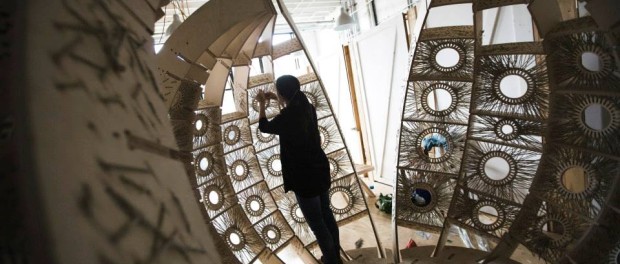Review of Sukkah City: Religious Tradition Meets Modern Design
In September 2010 a unique architectural competition was held in New York City. It involved putting a modern spin on an age old structure called a sukkah, a hut-like enclosure that plays an essential role in the Jewish holiday of Sukkot. The architectural show was created by journalist Joshua Foer and Roger Bennett and sponsored by Reboot, a Jewish cultural organization. In the documentary Sukkah City, director Jason Hutt gives viewers an exclusive glimpse backstage into the development of the project from its initial planning stages, the arduous jury selection process and selection of the twelve winning sukkah designs, the construction phase, the strategic installation of the structures in Union Square Park, as well as the actual two day Sukkah City event itself.
The film Sukkah City demonstrates how age-old traditions can evolve and adapt while still remaining relevant in our modern cultural milieu. For those filmgoers unfamiliar with Judaism and Jewish tradition, a sukkah is a temporary shelter commemorating the time when God provided for the Jews after they fled from Egypt. At the beginning of the Sukkah City viewers are informed about the various ancient laws regarding the construction of a sukkah. These include that it must have three walls but the third doesn’t need to be whole. Also, the roof must be made out of schach (non edible branches or leaves). Another important element of the sukkah experience is that at night occupants must be able to see the stars through the roof while during the day time hours there must be more shade than sun inside the structure.
One of the most interesting aspects of Sukkah City is how architects from around the world are able to come up with their own unique interpretations of the age old of structure. Despite having to comply with an array of strict rules and guidelines the designers (with one exception) are able to bring to life artistic and imaginative sukkahs using basic materials such as wood, wire, and cardboard.
One of the problems with documentary Sukkah City, however, is that at times it can be dry and overly technical. Early on in the film the director dedicates a lot of screen time to the exhaustive jury process and focuses on a number of jurors arguing over the merits of various sukkah designs. There are also a number of scenes in which architects discuss the practical aspects of their work and the types of design techniques that they use. For anyone who’s unfamiliar with architectural design these repetitive scenes come across as rather dull. From a strictly cinematic point of view these scenes also aren’t very visually interesting to watch. Perhaps the filmmaker should’ve devoted more time to exploring the cultural importance of sukkahs and their role in relation to modern Judaism and the religious traditions of today’s Jewish community.
Despite the fact that Sukkah City features some slow and dry moments, the twelve highly imaginative and creative sukkahs featured in the film are the highlight of this documentary. The basis of Sukkah City is the convergence of religion, artistic expression, and architecture. The construction of these sukkah structures also serve to symbolize the merging of practicality with spirituality as well as innovation with tradition.
Sukkah City is out now on First Run Features.






